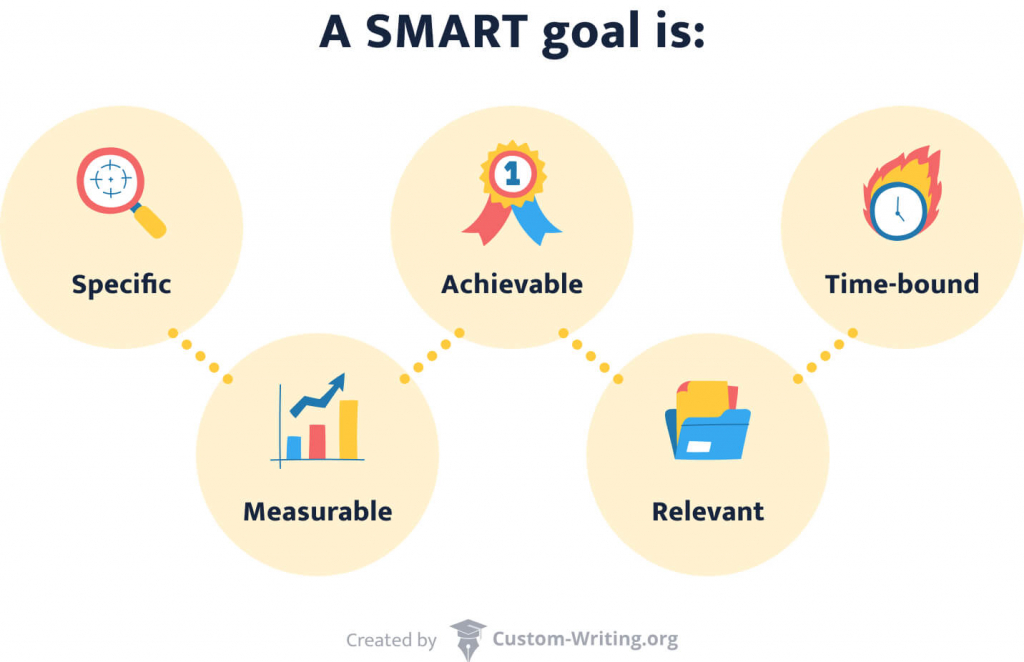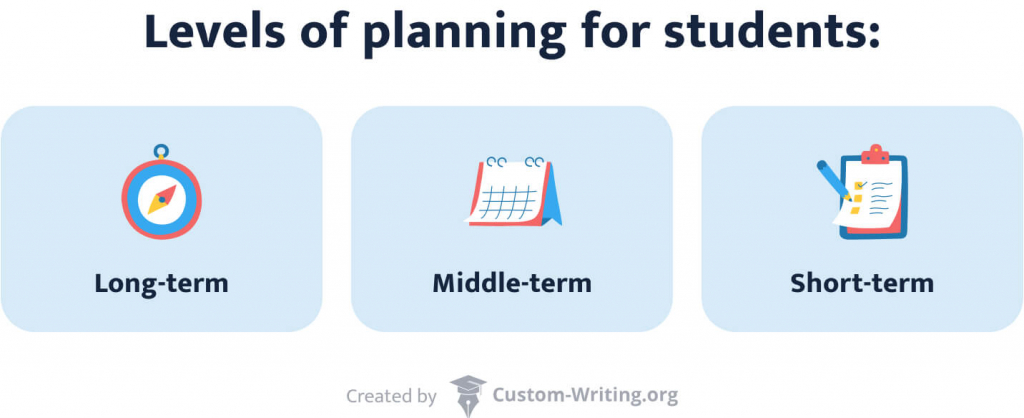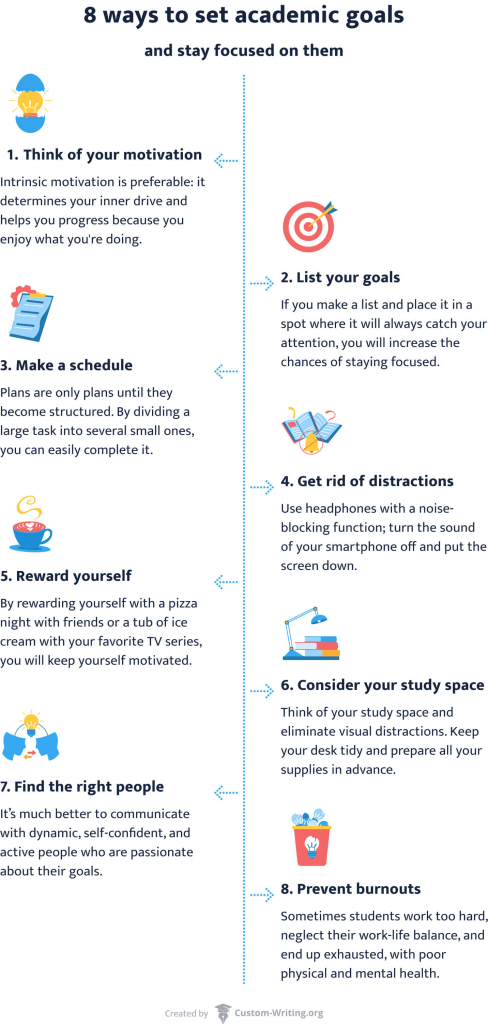Wise people say that living without a goal is like running a race without a finish line. No matter how hard you try, your journey leads you nowhere, and your immediate successes don’t give you a sense of accomplishment.

This type of lifestyle can be frustrating, especially because paying the bills or finishing your assignments doesn’t serve as a worthy life goal. A good way to give your life and studies more meaning, as well as make them more engaging and motivating, is to learn proper goal setting.
That’s what we’ll do in this article!
We will:
- Walk you through the SMART goal-setting method,
- Examine the 3 levels of goal setting,
- Describe 8 workable tips to stay focused on your priorities.
You’ll also get a handy set of conventional and online tools to help you define your goals well.
🎯 Why Are Educational Goals Important?
Ideally, any person pursuing education at a certain establishment (be it a school, a college, or a university) has the goal of graduating and starting a career.
But what should you do every day to achieve those goals?
An effective tool to guide you to that ultimate outcome is a well-formulated set of smaller, actionable objectives.
Educational goals are unique and depend on your scope of interests and your ambitions for the future.
Some good examples of academic goals for high school include:
- Improve your GPA consistently.
- Master academic research skills.
- Improve your writing mastery.
- Try a new extracurricular activity every semester.
- Look for volunteer opportunities.
- Build a portfolio of community-related projects.
These high school goals give structure to your studies and direct you toward continuous growth. By the time you transition from high school to college, you’ll have enough content on your resume to impress the committee.
4 Benefits of Setting Academic Goals
Now, what are the benefits of setting goals for the period of your education?

Here are the 4 main bonuses you will get from this exercise.
Greater Focus
Studying for the sake of studying is a process, not an outcome. Thus, you may quickly get lost and demotivated amid the endless chain of assignments, tests, and lectures. Writing down your educational goals gives more structure to the educational process and allows you to stay on track with your key educational priorities.
Broader Scope
Goal setting is a very informative and valuable intellectual exercise that allows students to understand themselves and their deeper life values. By looking at your educational and extracurricular interests, hobbies, and dreams, you can stay in harmony with your inner self and work toward achieving meaningful goals instead of just sticking to the curriculum.
Motivation
When you have a goal, it’s much easier to make yourself move toward it. So, if you’ve made it clear to yourself that this course is one of three to five stepping stones to the diploma that will help you get a dream career, travel abroad, or do something else of value and meaning, you will find the inner motivation to continue.
Progress Tracking
Motivation dies out when you see no end to meaningless assignments and tests. Finishing a course may seem vague and intimidating. But, for instance, if you see that you need to read 120 pages, write three essays, and make one PPT presentation to get credit and reach this goal, then the work process becomes much more manageable.
🤓 SMART Goal Setting for Students
SMART is an acronym for the parameters of an effective goal:
- Specific
- Measurable
- Achievable
- Relevant
- Time-Bound

Experts say that by making goals according to the SMART algorithm, you maximize the chances of attaining them. Let’s see how this works in practice.
Specific
Creating a specific goal means that it should be free from vagueness and generalities. This exercise becomes easier once you ask yourself the following questions:
- What exactly do I need to do?
- Who will be accountable for which part of the task?
- What do I need to do to get this goal accomplished?
Answers to these questions will help you to focus on the task’s specifics, giving you a direction for planning a task that seemed unclear and too broad.
For instance, a general goal, “I plan to study better,” can be made clearer by rephrasing it as follows:
Example:
“I plan to improve my GPA.”
Measurable
By definition, making your goal measurable means quantifying it. You can attain measurability by asking yourself:
- How much improvement/change do I want to attain?
- How will I know that the goal has been met?
By applying this exercise to the GPA-related goal we’ve just discussed, we can add measurability to it as follows:
Example:
“I plan to improve my GPA by 0.5 points.”
Achievable
The goal’s achievability is very important, as it gives your ambition a real shape. Setting too ambitious goals can block your progress and add another cause for frustration and low self-esteem. Thus, realistic and manageable goals work much better, giving you a sense of accomplishment and a drive to set and achieve new milestones.
To make our GPA goal more achievable, we can add a couple of details, focusing on the means of GPA improvement. Now our goal will look as follows:
Example:
“I plan to improve my GPA by 0.5 points by minimizing the number of missed lectures and submitting tasks on time.”
Relevant
Relevance is about your goal’s value and meaning, specifically for you. To make your SMART goal relevant, you should answer the following questions:
- Why am I setting that goal?
- What meaning does its attainment have for me?
- What will this goal give me?
By focusing on relevance, the GPA goal we’re developing will transform into the following:
Example:
“I plan to improve my GPA by 0.5 points by minimizing the number of missed lectures and submitting tasks on time to earn all the necessary credits and graduate without delays.”
Time-Bound
Success may take a long time if you don’t set any specific timeframe for your task. It’s vital to keep the goal finite and set a deadline by which you will assess the goal’s success. This may be done by asking such questions as:
- When should the task be finalized?
- How much time do I have for it?
- How much additional time can I afford for this task?
Adding the timeframe to our GPA goal, we get the following SMART goal outcome:
Example:
“I plan to improve my GPA by 0.5 points every semester in the coming academic year by minimizing the number of missed lectures and submitting tasks on time to receive all the necessary credits and graduate without delays.”
Please keep in mind that SMART is only one of the numerous goal-setting methods that you can use in your studies and life. You can try out the HARD, WOOP, OKR, or value-based goal-setting techniques and see which one works best for you. Find a host of workable options here.
🎓 Educational Goals & Levels of Planning
Instead of living every day with a set of short-term goals in mind, you may want to approach life as a project.
This idea was first proposed by Jean-Paul Sartre, a French playwright who believed in the fundamental freedom of individuals to make decisions and assume full responsibility for their actions. His approach can help you to visualize your life as an important project and therefore plan accordingly to achieve your set goals.

Students can apply Sartre’s ideology to systematically organize their lives to achieve life, career, and educational goals and enjoy the fruits of their labor. The strategies are mainly differentiated by timelines, levels of effort involved, and expected results. Here is how a student can set and meet their goals.
Long-term Goals for Students
Long-term goals are the desires, visions, and ambitions you set to accomplish within a significant amount of time and with much effort and resources.
The timeline for achieving these goals is from 1 to 20 years.
A long-term goal is usually the least pressing issue on a student’s list of needs; therefore, it is almost always the last task to get done. However, long-term goals are often the most important. Therefore, such goals require careful planning, resource allocation, hard work, and accountability.
Why Students Need Long-Term Goals
Those who don’t set goals can’t effectively identify where they need to go and what steps are required.
Long-term goals offer the following benefits:
Examples of Long-Term Goals
- Improve grades during a freshman year to raise your GPA. A school year is a long period, and there are many steps to take to reach a higher GPA in your classes.
- Win a scholarship. This may be of value both for your portfolio or resume and your self-esteem.
- Choose a major to focus on in your study program. This decision has a far-reaching impact on your career and life path.
- Get an internship in a desired organization. Internships are a bridge between studies and a career, so you should invest proper time and effort into choosing a place for an internship.
- Land a leadership position at school. Leaders do much better in their studies and careers, so leadership skills are always a good investment.
- Start a business project. Having a small business before graduation is a safe bet because it helps you pay the bills and stay afloat.
Middle-term Goals for Students
To achieve long-term goals, you should break down your larger vision into smaller, shorter-term objectives to stay motivated by intermediate wins. These shorter goals are called medium-term goals because they are longer in duration and broader in scope than short-term goals.
Benefits of Middle-Term Goals for Students
Examples of Middle-Term Goals for Students
So, what are some middle-term goals that a student can explore?
- Growing professional networks. This is a mid-term goal that can bring you closer to a long-term goal – getting a dream job.
- Keeping your CV updated at all times. This goal equips you for any attractive job vacancy that could pop up at any moment.
- Building influence within the community. Influential leaders are more noticeable and can receive better career and promotion opportunities.
- Earning a professional certificate. If you have the latest credentials and show that you’re always on the path toward self-improvement, your chances for successful employment grow exponentially.
Short-Term Goals for Students
Short-term goals are an even smaller step toward your educational success. They give your educational path meaning and your far-reaching goals measurability.
Why Students Need Short-Term Goals
Students need to set such goals because:
Examples of Short-Term Goals
Some examples of short-term goals you can set to see sizable improvements in your educational routines are as follows:
- Get up at 7 a.m. every working day. Morning routines are excellent productivity drivers, so this goal will surely benefit you.
- Arrange a tidy and well-organized workspace. Working at an organized desk, with all your supplies readily available, is much simpler than struggling with a mess.
- Submit all assignments on time for one month. Once you adopt the habit of being punctual with your tasks, you’ll see multiple benefits (higher GPA, good reputation, etc.).
- Open a savings account and set a fixed monthly sum for investment. Spare money will always be handy, and financial literacy is a vital lifelong skill.
- Read 50 pages a day (class and non-class readings). Reading makes everyone more intelligent!
- Attend a yoga class once a week. Your body and mind should be well-balanced to achieve optimal productivity.
- Talk to a counselor to control your level of study stress. It’s very easy to get into a rut, and counseling can help you avoid this.
To incorporate effective short-term planning into your daily routines, we recommend asking yourself the following questions:
- What can I do today, or even right now, to move closer to my long-term goals?
- How do my short-term plans fit into my long-term goals?
Practicing mindfulness in this way will add value and meaning to your daily educational activities and will reveal at which stage of your goal’s progress you currently are.
🏹 8 Ways to Set Academic Goals & Stay Focused on Them
Setting goals correctly is only part of your journey to educational success. The lion’s share of your achievement is sticking to those goals until you finish the set tasks.

Here are some workable tips to strengthen your commitment to your goals and raise your chances of delivering the goods.
1. Think of Your Motivation
Here it all boils down to two motivation types – intrinsic and extrinsic. The first type is preferable in your studies since it determines your inner drive and helps you progress because you enjoy what you’re doing. The second type presupposes doing something because you need to or have been told by others to do it.
Though intrinsic motivation is stronger, most people are driven by a fusion of intrinsic and extrinsic motives in most of their daily tasks.
How does it work?
Example:
For instance, you may sit down to write an essay because a professor assigned it to you and because you will get an F if you fail to deliver it on time.
This is an example of extrinsic motivation. Still, you can add some intrinsic motivation by developing a genuine interest in the task and approaching it with curiosity.
2. Make a List of Goals
The visibility of your goals is another success factor. Getting distracted from a goal because numerous events claim your attention is very easy. Your memory won’t keep a mental record of your goals for very long. But if you make a list and place it in a spot where it will always catch your attention, you will increase the chances of staying focused.
3. Make a Schedule
Plans are only plans until they become time-bound and structured.
Example:
Planning to write your essay “next week” is much different than “researching the materials on Tuesday, writing a 200-word outline on Wednesday, completing the draft on Thursday, and going over it on Friday.”
As you can see, the tasks are not that time-intensive, so they can easily be included in your daily to-do list. Thus, you will have an essay ready by Friday instead of spending a whole day on it during the weekend and then rushing to submit the text without properly editing it.
4. Get Rid of Distractions
We all live in highly distracting environments that destroy our concentration. Thus, it is vital to make proper arrangements to minimize distractions for the sake of working productively and reaching your goals.
It’s vital to keep your environment free from noise and digital distractions:
- Use headphones with a noise-blocking function if you work in a dorm room or coffee shop.
- Turn the sound of your smartphone off and put the screen down.
- All pop-up messages and social media notifications can wait until the end of your study session.
5. Reward Yourself
You won’t achieve your goals if you force yourself to study all day. A human brain can’t concentrate on one task all the time.
Example:
By recognizing your progress and rewarding yourself with a pizza night with friends or a tub of ice cream with your favorite TV series, you will help keep yourself motivated.
Besides, resting and rewarding yourself for your efforts is a sure way to keep your motivation high.
6. Consider Your Study Space
You should always consider the comfort of your study space and try to eliminate visual distractions. Keep your desk tidy and prepare all your supplies before sitting down to study, write, or research. This way, you will minimize the time needed to find all the necessary tools and instead be able to enjoy the overall process without unneeded stress about locating a pen or highlighter.
7. Surround Yourself with the Right People
We are all social creatures, so our self-esteem and productivity depend heavily on other people’s evaluations of our potential. Your motivation will likely die out quickly if you hear negative appraisals or criticism too often.
The same goes for overly self-critical and pessimistic people; they radiate negativity and can distance you from your goals. It’s much better to communicate with dynamic, self-confident, and active people who are passionate about their goals; you’re sure to get infected with the desire to act.
8. Check Yourself for Burnout
If you fail to progress toward your goal no matter how hard you try, it’s probably time to consult a counselor and check if you have burnout. Sometimes students work too hard, neglect their work-life balance, and end up exhausted, with poor physical and mental health. The best solution, in this case, is to engage in mindfulness activities (e.g., breathing exercises, yoga, walking) and get rid of distractions to stay focused and minimize the time spent on regular tasks.
🗒️ Top-10 Goal-Setting Tools
Now that you know a lot about goal setting, let’s look at the variety of tools you can apply to automate and speed up the process.
There are plenty of traditional, paper-based tools to help you to set your goals, as well as online versions of goal-setting techniques for fans of digital technology.
Traditional Instruments
You can easily write down and structure your goals using a pen and paper. Here are some well-known, conventional methods of completing this task.
1. One Year from Now
Here is a valuable visualization exercise for those who experience problems with setting goals.
How to do it?
Imagine yourself 1 year from now and think of what you would ideally see. What person would you like to become in one year? Focus on specific aspects, like having a diploma, a relationship, a financial plan, and a specific lifestyle.
After composing this image, think of the steps you need to take to bridge that ideal future version of yourself and your current state.
2. Goal-Setting Journal
Journaling is a great option for people who are on the path of attaining a goal and must work out their unique ways of achieving it.
The journal may contain a list of goals you’ve initially set and then specify your steps with reflections on what works for you and what doesn’t. Approach it as a learning experience, and you will get better at goal achievement quickly.
3. Support Group
It’s much easier to attain your goals if you’re held accountable by a group of like-minded individuals.
Find such people in your social surroundings and work toward a goal with their support and encouragement.
4. Whiteboard
If you have a whiteboard in your room, there’s nothing better than writing your goals in large letters and looking at them daily. This method is very good for keeping yourself focused.
Online Instruments
Here is a list of online tools you can also use for effective goal setting and progress tracking in real-time.
1. Trello
Though Trello is famous for teamwork management, it’s also invaluable for goal setting. You can use Trello boards for annual, monthly, weekly, and daily goals.
How to do that?
Just create a tab for every goal category and then add the boards with lists of goals. Switching between goals of various time horizons and ticking off the goals you have already achieved will be simpler.
2. Todoist
Todoist offers visual structure and organization to your goal-setting and goal-achievement activities. It allows hassle-free combinations of smaller goals into bigger ones, as well as their continuous tracking.
3. Basecamp
Google’s project management app gives a lot of space for goal setting.
How to use it?
- Create numerous to-do lists,
- Organize them by priority,
- Break them down into key milestones,
- Combine several smaller goals under a broader, long-term goal.
4. Goal Buddy
Goal Buddy is specifically meant to set SMART goals. It offers prompts and guides you through the process of goal formulation. Users can also track those goals in the app’s interface.
5. Asana
Asana is another top-tier goal-setting and tracking tool.
It promotes a two-component approach to setting goals:
- The goals themselves,
- The ultimate results you want to attain.
The tool simplifies tracking the goal’s deadlines and allows you to add criteria for the goal’s success evaluation.
Thank you for reading this article!
With this information, you’re better positioned to make wise decisions and set smart goals. Think of goal setting in strategic terms and never postpone this exercise for later. The quality and precision of your goals determine your performance today. If you liked this article, don’t hesitate to share it with your friends to help them improve their life-planning skills.
🔗 References
- 10 Educational Goal Examples – Indeed
- Personal Goal Setting – Planning to Live Your Life Your Way
- How to Set Goals and Achieve Them: 7 Simple Strategies
- SMART Goals: A How to Guide
- What are SMART Goals?
- Types of Planning Overview & Purpose
- How to stay focused to achieve your goals
- How to Focus And Stay Sharp (A Comprehensive Guide)
![The Scaffolding Technique in Education: Benefits & Examples [Is It Really Useful?]](https://custom-writing.org/blog/wp-content/uploads/2023/03/business-women-signature-document-1-284x153.jpg)







![How to Deal with FOMO in College [+Turn It into JOMO]](https://custom-writing.org/blog/wp-content/uploads/2022/10/smiling-african-student-pointing-with-pencil-laptop-screen-concentrated-blonde-woman-glasses-propping-chin-with-hand-while-working-with-computer-office-1-284x153.jpg)

![How to Get Perfect Letters of Recommendation for College [Guide]](https://custom-writing.org/blog/wp-content/uploads/2022/08/NA_SEP._14-284x153.jpg)
